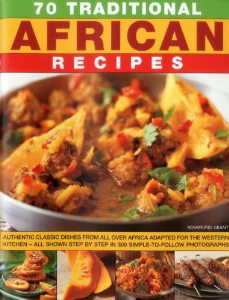Cooking Outside the Comfort Zone
 70 TRADITIONAL AFRICAN RECIPES
70 TRADITIONAL AFRICAN RECIPES
Authentic Classic Dishes from all over Africa Adapted for the Western Kitchen
By Rosamund Grant
Southwater Books
96 pp.
In melting-pot America with a choice of restaurants reflecting our global world, it can be difficult for adventurous and seasoned eaters to find entire cuisines, flavor profiles, or ingredients that are wholly new to them. Yet, beyond Ethiopian and Moroccan, most Americans, including DCCC members, surely have little idea of what comprises African cooking. So it is with nearly blank palates, that we approached the most recent DCCC pick.
The flavor, ingredients, and techniques of African cooking took us out of familiar territory, pushing the envelope. I found, however, that the more I ate the more I liked. After several weeks of cooking the mostly very simple-to-prepare foods from 70 Traditional African Recipes, I had developed a taste for it! My African palate was no longer blank.
Besides the excitement of developing a taste for a new food, there is another benefit to exploring African cooking: If you are fond of southern American cooking, and in particular soul food, as I am, you will find it interesting to explore the cuisine of Africa, particularly West Africa, where some of the roots of this cooking lie.
Club members’ favorite recipes include Kachumbali, a lemony, spicy relish-cum-salad (depending on how you slice it) that DCCC member Jenn made weekly and that I found went extremely well with Gari Foto, a pleasantly spicy buttery sauté of onion, tomatoes, carrots, sweet corn and red bell peppers bulked up with tomato paste and gari, a coarsely ground flour made from cassava; Joloff Chicken and Rice; Chicken with Lentils; East African Roast Chicken; Kofta Curry; Green Lentil Salad; all of the fish recipes; Groudnut Soup; Black-eyed Bean Stew with Spicy Pumpkin; Ethiopian Collard Greens, which were a favorite of all in the club who tried them; and Egusi Spinach and Egg. (Egusi is a coarse flour made of ground melon or other fruit seeds.)
Published by a British publisher, there are several Briticisms in the book, some charming—such as the author’s reference to the recipe for Kofta Curry as “fiddly,” which, by the way, DCCC member Melanie made and loved and did not find fiddly relative to the deliciousness of the dish—and some which can be frustrating but educational for those who like to do a little sleuthing. The recipe for Black-eyed Bean Stew with Spicy Pumpkin, for example, calls for “mixed spice,” for which there is no recipe; a bit of research online revealed that this spice mixture, sometimes called “pudding spice,” is a blend of sweet and aromatic spices such as but not limited to cinnamon, clove, mace, nutmeg, coriander, and allspice in varying quantities. And after working my way through a few recipes I came to understand that what the author refers to as tomato puree is what Americans call tomato paste.
These Briticisms are only a minor inconvenience at most in what is an excellent introduction to one of the world’s lesser known but delicious cuisines. In 70 Traditional African Recipes Rosamund Grant has pulled together a taste of Africa that is worthy of exploration.
